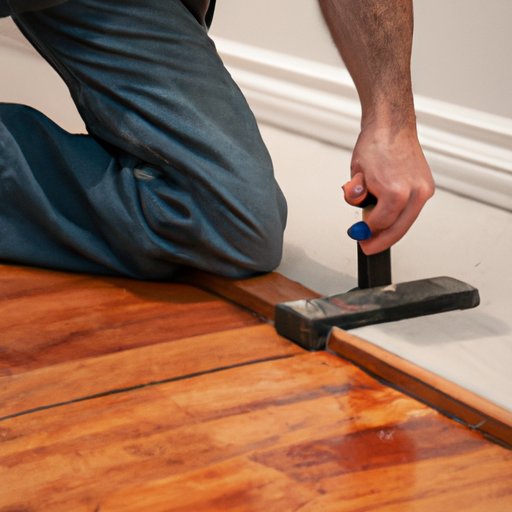
Introduction
Have you ever felt like your floors were talking to you? That annoying squeaking sound that occurs when you step on them can be extremely irritating and embarrassing when you have guests over. Not to mention, squeaky floors can cause structural damage and reduce the value of your home. In this article, we’ll show you how to fix squeaky floors on your own without spending a fortune.
Identify the Source of the Squeak
The first step in fixing squeaky floors is identifying the source of the problem. Here are a few reasons why you might be experiencing squeaky floors:
- Loose nails or screws
- Wood rubbing against wood
- Humidity/moisture changes in the air
- Shrinkage or expansion of the wood
To identify the source of the squeak, you’ll need to walk around the floor and try to locate the areas with the most noise. Once you’ve identified the areas, test them by applying pressure to see where exactly the sound is coming from.
Tighten the Floorboard
One of the most common reasons for squeaky floors is loose nails or screws. Tightening these elements is relatively easy and requires the following tools:
- Screwdriver or hammer
- Drill and screws
To fix the problem, you’ll need to locate the loose boards and then screw them back into the joists. Be careful not to over-tighten the screws as it can cause damage to the board.
Lubricate the Joints
If the squeak is caused by friction between two floorboards, lubricating the joints can help. The two best substances to do this with are talcum and graphite powder. Here’s how to apply them:
- Clean the area where the two floorboards meet
- Apply a liberal amount of talcum powder or graphite powder
- Gently tap the boards together to spread the powder
- Wipe off the excess powder with a cloth
You may have to repeat the process if the squeak persists.
Replace the Damaged Board
If all else fails, the problem may be a damaged floorboard. You’ll need to remove the board and replace it, following these steps:
- Use a circular saw to cut along the center of the board
- Make two perpendicular cuts at the end of the initial one to create an L shape
- Remove the cut pieces with a chisel
- Use the cut-out board as a model when getting the new board
- Install the new board and secure it with screws
It’s important to note that if the damaged board is part of a tongue and groove system, you may need to remove more boards to access it.
Reinforce the Subfloor
If the problem persists even after replacing the damaged board, it might be time to add support to the subfloor. Here are the tools you’ll need:
- 2 x 4 wooden beams
- Joist hangers
- Nails and screws
Follow these steps to reinforce the subfloor:
- Measure the area where the subfloor needs reinforcing
- Cut a wooden beam to fit the measurements
- Secure the beam to the joist using the joist hanger and nails/screws
- Repeat the process with additional beams until the subfloor is sturdy
Use a Filler
If none of the previous methods work, you can opt for using a filler. Here are two of the most popular types:
- Wood filler: A mix of sawdust and wood glue, it should match the color of your floor.
- Epoxy filler: A two-part mixture that hardens much like plastic.
When using a filler, remember that it’s essential to find the source of the squeak before applying it. Here’s how to use a filler:
- Clean the area where you will apply the filler
- Fill the gap with the filler of your choice
- Smooth out the surface with a putty knife
- Let it dry for a day and sand it down until it becomes level with the rest of the floor
Hire a Professional
If all else fails, hiring a professional might be the best option. Reasons to do so include:
- The issue is beyond your skill set
- The floor is too old and requires a complete restoration
- You would like a professional opinion on which method is best
When hiring a professional, make sure you get several quotes and research the company beforehand.
Conclusion
Squeaky floors can be extremely annoying, but they don’t have to be permanent. Identifying the source of the squeak and using one of the techniques we’ve outlined can help. If all else fails, hiring a professional is always an option. By fixing your squeaky floors, you’re preventing further damage to your home and increasing its value.





